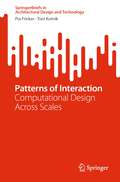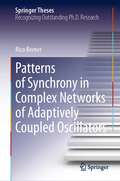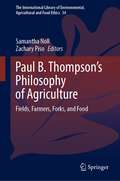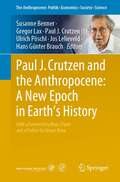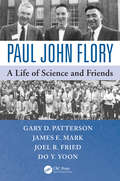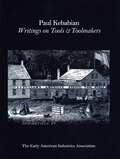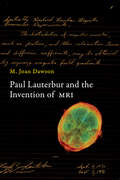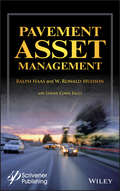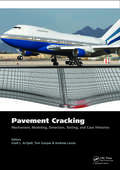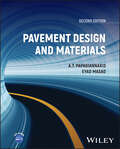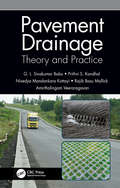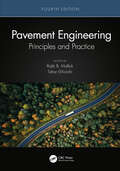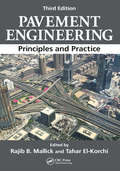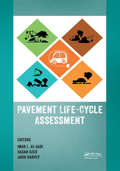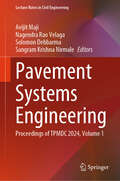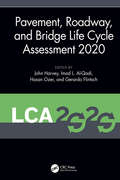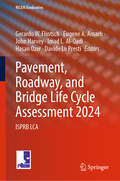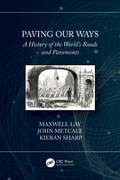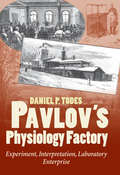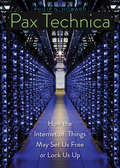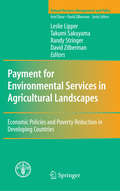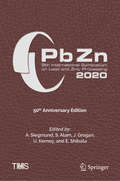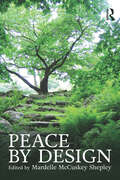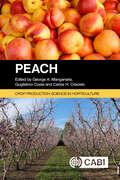- Table View
- List View
Patterns of Interaction: Computational Design Across Scales (SpringerBriefs in Architectural Design and Technology)
by Pia Fricker Toni KotnikThis book is a reflection on contemporary computational design thinking at the intersection of architecture, urban design, and landscape architecture, in a time marked by complex challenges like climate change, urbanization and population growth. Based on a critical rethinking of the notion of ground and the relation between the manmade and the natural environment, an understanding of architecture as regenerative practice is proposed. It aims at a built environment as landscape, at an architecture of prosthetic nature. The design approach is illustrated by a number of design experiments conducted within a studio setting and complemented by a series of conversations with leading experts on sustainable design and landscape architecture.
Patterns of Synchrony in Complex Networks of Adaptively Coupled Oscillators (Springer Theses)
by Rico BernerThe focus of this thesis is the interplay of synchrony and adaptivity in complex networks. Synchronization is a ubiquitous phenomenon observed in different contexts in physics, chemistry, biology, neuroscience, medicine, socioeconomic systems, and engineering. Most prominently, synchronization takes place in the brain, where it is associated with cognitive capacities like learning and memory, but is also a characteristic of neurological diseases like Parkinson and epilepsy. Adaptivity is common in many networks in nature and technology, where the connectivity changes in time, i.e., the strength of the coupling is continuously adjusted depending upon the dynamic state of the system, for instance synaptic neuronal plasticity in the brain. This research contributes to a fundamental understanding of various synchronization patterns, including hierarchical multifrequency clusters, chimeras and other partial synchronization states. After a concise survey of the fundamentals of adaptive and complex dynamical networks and synaptic plasticity, in the first part of the thesis the existence and stability of cluster synchronization in globally coupled adaptive networks is discussed for simple paradigmatic phase oscillators as well as for a more realistic neuronal oscillator model with spike-timing dependent plasticity. In the second part of the thesis the interplay of adaptivity and connectivity is investigated for more complex network structures like nonlocally coupled rings, random networks, and multilayer systems. Besides presenting a plethora of novel, sometimes intriguing patterns of synchrony, the thesis makes a number of pioneering methodological advances, where rigorous mathematical proofs are given in the Appendices. These results are of interest not only from a fundamental point of view, but also with respect to challenging applications in neuroscience and technological systems.
Paul B. Thompson's Philosophy of Agriculture: Fields, Farmers, Forks, and Food (The International Library of Environmental, Agricultural and Food Ethics #34)
by Zachary Piso Samantha NollThis book explores the philosophical thought and praxis of Paul B. Thompson, who planted some of the first seeds of philosophy of agriculture and whose work inspires interdisciplinary scholarship in food ethics, biotechnology, and environmental philosophy. Landmark texts such as The Spirit of the Soil, The Agrarian Vision, and From Field to Fork revealed the fertility of food systems for inspiring reflection on our relationships to technology, the land, and one another. Rooted in philosophical traditions ranging from pragmatism to post-phenomenology, Thompson’s work nourishes projects in ethics, epistemology, philosophy of science, and social and political theory, not only in academic philosophy departments but also in the social and natural sciences. This volume collects this diversity of thought in a tour of the many fields of food systems; from theorizing the sustainability of agroecological systems, to appreciating the quotidian practice of agrarian communities, to anticipating the impacts of emerging biotechnology, and to savoring the roles that food plays in forming our identities. Composed by an international crop of scholars working on the future of food ethics, the volume is a vital contribution to scholars and practitioners thinking through our relationships to the food systems that sustain us.
Paul J. Crutzen and the Anthropocene: A New Epoch in Earth’s History (The Anthropocene: Politik—Economics—Society—Science #1)
by Hans Günter Brauch Paul J. Crutzen Susanne Benner Gregor Lax Ulrich Pöschl Jos LelieveldThis book outlines the development and perspectives of the Anthropocene concept by Paul J. Crutzen and his colleagues from its inception to its implications for the sciences, humanities, society and politics.The main text consists primarily of articles from peer-reviewed scientific journals and other scholarly sources. It comprises selected articles on the Anthropocene published by Paul J. Crutzen and a selection of related articles, mostly but not exclusively by colleagues with whom he collaborated closely.• In the year 2000 Nobel Laureate Paul J. Crutzen proposed the Anthropocene concept as a new epoch in Earth’s history • Comprehensive collection of articles on the Anthropocene by Paul J. Crutzen and his colleagues• Unique primary research literature and Crutzen’s comprehensive bibliography• Paul Crutzen’s scientific investigations into human influences on atmospheric chemistry and physics, the climate and the Earth system, leading to the conception of the Anthropocene• Reflections on the Anthropocene and its implications• Bibliometric review of the spread of the use of the Anthropocene concept in the Natural and Social Sciences, Humanities and Law
Paul John Flory: A Life of Science and Friends
by Gary D. Patterson James E. Mark Joel Fried Do YoonPaul John Flory: A Life of Science and Friends is the first full-length treatment of the life and work of Paul John Flory, recipient of the Nobel Prize in chemistry in 1974. It presents a chronological progression of his scientific, professional, and personal achievements as recounted and written by his former students and colleagues.This book cove
Paul Kebabain: Writings on Tools & Toolmakers
by The Early American Industry AssociationOne of the most important parts of a serious tool collector s collection is the written material used to research and learn about the artifacts they accumulate. In 2003, for the Annual Meeting of the Early American Industries Association, 14 articles by Paul Kebabian on a variety of tools, toolmakers and early trades were published as this collection. Kebabian, a librarian by vocation, has had many of his writings on tools and toolmakers appear in newsletters and journals such as ACTIVE, Scrapbooks, and The Chronicle.
Paul Lauterbur and the Invention of MRI
by M. Joan DawsonThe story behind the invention of the most important medical diagnostic tool since the X-ray.On September 2, 1971, the chemist Paul Lauterbur had an idea that would change the practice of medical research. Considering recent research findings about the use of nuclear magnetic resonance (NMR) signals to detect tumors in tissue samples, Lauterbur realized that the information from NMR signals could be recovered in the form of images—and thus obtained noninvasively from a living subject. It was an unexpected epiphany: he was eating a hamburger at the time. Lauterbur rushed out to buy a notebook in which to work out his idea; he completed his notes a few days later. He had discovered the basic method used in all MRI scanners around the world, and for this discovery he would share the Nobel Prize for Physiology or Medicine in 2003. This book, by Lauterbur's wife and scientific partner, M. Joan Dawson, is the story of Paul Lauterbur's discovery and the subsequent development of the most important medical diagnostic tool since the X-ray.With MRI, Lauterbur had discovered an entirely new principle of imaging. Dawson explains the science behind the discovery and describes Lauterbur's development of the idea, his steadfastness in the face of widespread skepticism and criticism, and related work by other scientists including Peter Mansfield (Lauterbur's Nobel co-recipient), and Raymond Damadian (who famously feuded with Lauterbur over credit for the ideas behind MRI). She offers not only the story of one man's passion for his work but also a case study of how science is actually done: a flash of insight followed by years of painstaking work.
Pavement Asset Management
by Ralph Haas W. Ronald Hudson Lynne Cowe FallsComprehensive and practical, Pavement Asset Management provides an essential resource for educators, students and those in public agencies and consultancies who are directly responsible for managing road and airport pavements. <P><P>The book is comprehensive in the integration of activities that go into having safe and cost-effective pavements using the best technologies and management processes available. This is accomplished in seven major parts, and 42 component chapters, ranging from the evolution of pavement management to date requirements to determining needs and priority programming of rehabilitation and maintenance, followed by structural design and economic analysis, implementation of pavement management systems, basic features of working systems and finally by a part on looking ahead. The most current methodologies and practical applications of managing pavements are described in this one-of-a-kind book. Real world up-to-date examples are provided, as well as an extensive list of references for each part.
Pavement Cracking: Mechanisms, Modeling, Detection, Testing and Case Histories
by Andreas Loizos Tom Scarpas Imad L. Al-QadiInternationally, much attention is given to causes, prevention, and rehabilitation of cracking in concrete, flexible, and composite pavements. The Sixth RILEMInternational Conference on Cracking in Pavements (Chicago, June 16-18, 2008) provided a forum for discussion of recent developments and research results.This book is a collection of papers fr
Pavement Design and Materials
by A. T. Papagiannakis E. A. MasadPractical guide for all aspects of pavement engineering, updated with the latest techniques, standards, and software The newly revised and updated Second Edition of Pavement Design and Materials offers a comprehensive treatment of pavement materials, structural analysis, design, evaluation, and economic analysis of asphalt and portland concrete pavements. Written by two highly qualified engineering professors with a wealth of experience in the field, Pavement Design and Materials provides readers with: State-of-the-art techniques for material characterization, including a linear viscoelasticity primer Methods and software for the analysis of flexible and ridgid pavements including the AASHTOWare Pavement ME Design State-of-the-art pavement evaluation techniques including moduli backcalculation methods Pavement economic analysis techniques including the most up-to-date user cost relationships. The book companion website provides: Solved examples in each chapter and the electronic files associated with them An instructor solutions manual for the problems provided at the end of each chapter PowerPoint presentations by chapter to facilitate lecture delivery Pavement Design and Materials is an essential up-to-date textbook on the subject for upper-level undergraduate and graduate level courses on pavement materials and pavement design. It is also a valuable reference for practicing professional engineers involved in the various aspects of roadway pavement material selection and structural design.
Pavement Drainage: Theory and Practice
by G L Babu Prithvi S. Kandhal Nivedya Mandankara Kottayi Rajib Basu Mallick Amirthalingam VeeraragavanSUMMARY This book provides complete coverage of surface and subsurface drainage of all types of pavements for highways, urban roads, parking lots, airports, and container terminals. It provides up-to-date information on the principles and technologies for designing and building drainage systems and examines numerous issues, including maintenance and designing for flood events. Practical considerations and sophisticated analysis, such the use of the finite element method and unsaturated soil mechanics, anisotropy and uncertainties, are presented. This book allows civil engineers to make the best use of their resources to provide cost effective and sustainable pavements. Features Presents a holistic consideration of drainage with respect to pavement performance. Includes numerous practical case studies. Examines flooding and the impacts of climate change. Includes PowerPoint slides which include quizzes, schematics, figures, and tables.
Pavement Engineering: Principles and Practice
by Rajib B. Mallick Tahar El-KorchiPavement Engineering: Principles and Practice examines a wide range of topics in asphalt and concrete pavements from soil preparation and structural design to life cycle costing and economic analysis. This updated Fourth Edition covers all concepts and practices of pavement engineering in terms of materials, design, and construction methods for both flexible and rigid pavements and includes the latest developments in recycling, sustainable pavement materials, and resilient infrastructure. New and updated topics include material characterization concepts and tests, pavement management concepts, probabilistic examples of life cycle cost analysis, end-of-life considerations, waste plastic in asphalt, pervious concrete, pavement monitoring instrumentation and data acquisition, and more. The latest updated references, state of the art reviews, and online resources have also been included.
Pavement Engineering: Principles and Practice, Third Edition
by Rajib B. Mallick Tahar El-KorchiPavement Engineering will cover the entire range of pavement construction, from soil preparation to structural design and life-cycle costing and analysis. It will link the concepts of mix and structural design, while also placing emphasis on pavement evaluation and rehabilitation techniques. State-of-the-art content will introduce the latest concepts and techniques, including ground-penetrating radar and seismic testing. This new edition will be fully updated, and add a new chapter on systems approaches to pavement engineering, with an emphasis on sustainability, as well as all new downloadable models and simulations.
Pavement Life-Cycle Assessment: Proceedings of the Symposium on Life-Cycle Assessment of Pavements (Pavement LCA 2017), April 12-13, 2017, Champaign, Illinois, USA
by Imad L. Al-Qadi & Hasan Ozer and John HarveyAn increasing number of agencies, academic institutes, and governmental and industrial bodies are embracing the principles of sustainability in managing their activities and conducting business. Pavement Life-Cycle Assessment contains contributions to the Pavement Life-Cycle Assessment Symposium 2017 (Champaign, IL, USA, 12-13 April 2017) and discusses the current status of as well as future developments for LCA implementation in project- and network-level applications. The papers cover a wide variety of topics: - Recent developments for the regional inventory databases for materials, construction, and maintenance and rehabilitation life-cycle stages and critical challenges- Review of methodological choices and impact on LCA results- Use of LCA in decision making for project selection- Implementation of case studies and lessons learned: agency perspectives- Integration of LCA into pavement management systems (PMS)- Project-level LCA implementation case studies- Network-level LCA applications and critical challenges- Use-phase rolling resistance models and field validation- Uncertainty assessment in all life-cycle stages- Role of PCR and EPDs in the implementation of LCA Pavement Life-Cycle Assessment will be of interest to academics, professionals, and policymakers involved or interested in Highway and Airport Pavements.
Pavement Systems Engineering: Proceedings of TPMDC 2024, Volume 1 (Lecture Notes in Civil Engineering #653)
by Avijit Maji Nagendra Rao Velaga Solomon Debbarma Sangram Krishna NirmaleThis book is a collection of selected research papers from the 15th conference of the Transportation Planning and Implementation Methodologies for Developing Countries (TPMDC 2024). It covers the broad area of transportation planning and policy, pavement design and engineering, emerging technologies in transportation, traffic management, operations, and safety, and sustainable mobility in transportation. The book aims to provide deeper understanding of the transportation issues, solutions, and learnings from the implemented solutions. This book will be of best interest for academicians, researchers, policy makers, and practitioners.
Pavement, Roadway, and Bridge Life Cycle Assessment 2020: Proceedings of the International Symposium on Pavement. Roadway, and Bridge Life Cycle Assessment 2020 (LCA 2020, Sacramento, CA, 3-6 June 2020)
by John HarveyAn increasing number of agencies, academic institutes, and governmental and industrial bodies are embracing the principles of sustainability in managing their activities. Life Cycle Assessment (LCA) is an approach developed to provide decision support regarding the environmental impact of industrial processes and products. LCA is a field with ongoing research, development and improvement and is being implemented world-wide, particularly in the areas of pavement, roadways and bridges. Pavement, Roadway, and Bridge Life Cycle Assessment 2020 contains the contributions to the International Symposium on Pavement, Roadway, and Bridge Life Cycle Assessment 2020 (Davis, CA, USA, June 3-6, 2020) covering research and practical issues related to pavement, roadway and bridge LCA, including data and tools, asset management, environmental product declarations, procurement, planning, vehicle interaction, and impact of materials, structure, and construction. Pavement, Roadway, and Bridge Life Cycle Assessment 2020 will be of interest to researchers, professionals, and policymakers in academia, industry, and government who are interested in the sustainability of pavements, roadways and bridges.
Pavement, Roadway, and Bridge Life Cycle Assessment 2024: ISPRB LCA (RILEM Bookseries #51)
by John Harvey Imad L. Al-Qadi Hasan Ozer Gerardo W. Flintsch Eugene A. Amarh Davide Lo PrestiThis book highlights the latest advances, innovations, and applications in the field of LCA in pavements, bridges, and roadways, as presented by leading international researchers at the 6th International Symposium on Pavement, Roadway, and Bridge Life Cycle Assessment (ISPRB LCA2024), held in Arlington, VA, USA, on June 6–8, 2024. It covers a diverse range of topics concerning assessment of environmental impacts of pavements, bridges, and roadways, including environmental product declarations (EPDs) and use of life cycle assessment (LCA) in design, data, and case studies: LCA methodologies for transportation infrastructure, durability and service life assessments, maintenance strategies to enhance performance and minimize environmental impacts, evaluating the environmental impacts of materials and construction, recycling and reuse of materials, carbonation of concrete, pavement vehicle interaction, life cycle thinking in climate change planning, and climate change mitigation. The contributions, which were selected by means of a rigorous international peer-review process, present a wealth of exciting ideas that will open novel research directions and foster new multidisciplinary collaborations.
Paving Our Ways: A History of the World’s Roads and Pavements
by John Metcalf Max Gordon Lay Kieran SharpPaving Our Ways covers the international history of road paving in an interesting, readable and technically accurate way. It provides an overview of the associated technologies in a historical context. It examines the earliest pavements in Egypt and Mesopotamia and then moves to North Africa, Crete, Greece and Italy, before a review of pavements used by the Romans in their magnificent road system. After its empire collapsed, Roman pavements fell into ruin. The slow recovery of pavements in Europe began in France and then in England. The work of Trésaguet, Telford and McAdam is examined. Asphalt and concrete slowly improved as paving materials in the second part of the 19th century. Major advances occurred in the 20th century with the availability of powerful machinery, pneumatic tyres and bitumen. The advances needed to bring pavements to their current development are explored, as are the tools for financing, constructing, managing and maintaining pavements. The book should appeal to those interested in road paving, and in the history of engineering and transport. It can also serve as a text for courses in engineering history.
Pavlov's Physiology Factory: Experiment, Interpretation, Laboratory Enterprise
by Daniel P. TodesRussian physiologist and Nobel Prize winner Ivan Pavlov is most famous for his development of the concept of the conditional reflex and the classic experiment in which he trained a dog to salivate at the sound of a bell. In Pavlov's Physiology Factory: Experiment, Interpretation, Laboratory Enterprise, Daniel P. Todes explores Pavlov's early work in digestive physiology through the structures and practices of his landmark laboratory—the physiology department of the Imperial Institute for Experimental Medicine. In Lectures on the Work of the Main Digestive Glands, for which Pavlov won the Nobel Prize in 1904, the scientist frequently referred to the experiments of his coworkers and stated that his conclusions reflected "the deed of the entire laboratory." This novel claim caused the prize committee some consternation. Was he alone deserving of the prize? Examining the fascinating content of Pavlov's scientific notes and correspondence, unpublished memoirs, and laboratory publications, Pavlov's Physiology Factory explores the importance of Pavlov's directorship of what the author calls a "physiology factory" and illuminates its relationship to Pavlov's Nobel Prize-winning work and the research on conditional reflexes that followed it.Todes looks at Pavlov's performance in his various roles as laboratory manager, experimentalist, entrepreneur, and scientific visionary. He discusses changes wrought by government and commercial interests in science and sheds light on the pathways of scientific development in Russia—making clear Pavlov's personal achievements while also examining his style of laboratory management. Pavlov's Physiology Factory thus addresses issues of importance to historians of science and scientists today: "big" versus "small" science, the dynamics of experiment and interpretation, and the development of research cultures.
Pax Technica
by Philip N. HowardShould we fear or welcome the internet's evolution? The "internet of things" is the rapidly growing network of everyday objects--eyeglasses, cars, thermostats--made smart with sensors and internet addresses. Soon we will live in a pervasive yet invisible network of everyday objects that communicate with one another. In this original and provocative book, Philip N. Howard envisions a new world order emerging from this great transformation in the technologies around us. Howard calls this new era a Pax Technica. He looks to a future of global stability built upon device networks with immense potential for empowering citizens, making government transparent, and broadening information access. Howard cautions, however, that privacy threats are enormous, as is the potential for social control and political manipulation. Drawing on evidence from around the world, he illustrates how the internet of things can be used to repress and control people. Yet he also demonstrates that if we actively engage with the governments and businesses building the internet of things, we have a chance to build a new kind of internet--and a more open society.
Payment for Environmental Services in Agricultural Landscapes
by David Zilberman Takumi Sakuyama Leslie Lipper Randy StringerIn recent years, development policy has responded to an increasing concern about natural resource degradation by setting up innovative payment for environmental services (PES) programs in developing countries. PES programs use market and institutional incentives in order to meet both environmental and poverty alleviation objectives. However, their optimal design, implications for the rural poor, and how these initiatives integrate into international treaties on global warming and biodiversity loss are still being discussed. This book addresses these issues by scrutinizing analytical tools, providing policy insights and stimulating debate on linkages between poverty alleviation and environmental protection. In particular, it turns attention towards the role of environmental services in agricultural landscapes as they provide a living for many poor in developing countries. It serves as a valuable reference for academics and students in various disciplines, as well as for policy makers and advisors. This book is a co-publication between Springer and the Food and Agriculture Organization of the United Nations.
PbZn 2020: 9th International Symposium on Lead and Zinc Processing (The Minerals, Metals & Materials Series)
by J. Grogan A. Siegmund S. Alam U. Kerney E. ShibataEstablished in 1970, the PbZn symposium series is considered the leading international technical forum for the lead and zinc processing industries. The PbZn 2020 volume addresses all aspects of current processing technologies for primary and secondary lead and zinc, as well as emerging technologies for both metals.
Peace by Design
by Mardelle McCuskey ShepleyWe live in an era in which designers will make an essential and critical contribution to the health and success of humanity. Design can promote healing in healthcare environments, contribute to good mental health, reduce gun violence, and positively impact health and racial equity, all of which contribute to providing a more peaceful world.The primary focus of this book is to inspire young designers, academics, and practitioners to achieve their maximum societal contribution. It also supports experienced designers seeking reaffirmation of their social goals. To provide a foundation, the first chapter discusses the definition of design and design thinking and evidence regarding the direct and indirect contributions of design to peace. The subsequent chapters address peace endeavors at six scales of the physical environment: sustainable and equitable design, landscape architecture, architecture, interior design, industrial design, and graphic design. Additionally, nine short cameos are provided by contributors from various disciplines, who provide their favorite examples of “peace projects.” Peace can be manifested at multiple levels: world-wide, neighborhood and community, familial, or individual, and the various authors discuss portions from this spectrum. They broadly endorse disciplinary entanglements as a means of addressing societal and sustainability challenges and celebrate the impact of collaboration.This book is essential reading for students and practitioners representing all fields of design, including graphic design, industrial design, interior design, architecture, landscape architecture, and urban design.
Peace of Mind in Earthquake Country
by Peter YanevThe geologic, architectural and structural hazards of earthquakes, and how to recognize, avoid or correct them.
Peach (Crop Production Science in Horticulture)
by Maria Luisa Badenes Gregory Reighard Daniele Bassi James Adaskaveg David Ritchie Daniela Giovannini Nikolaos T Papadopoulos Helga Förster Thomas M Gradziel Gemma Echeverria Gregory A Lang B. Anthony B. Blaauw C. Bonghi A. Botton M. Cirilli Luis Cisneros-Zevallos M. Christofi B. Dichio M. F. Drincovich P. Drogoudi S. Foschi K. Gasic I. Iglesias J. C. Melgar P. Milonas I. S. Minas B. Morandi M. Á. Moreno A. L. Nielsen J. Pieper G. Reig S. Sansavini Guido Schnabel P. Tonutti L. Trainotti A. R Vicente C. XiloyannisPeach is a highly valuable temperate fruit crop with significant consumer demand and nutraceutical benefits. This book provides comprehensive and up-to-date coverage on sustainable production processes for peach and nectarine. The latter is a natural mutation of peach that lacks fuzzy skin. It includes fundamental information to help reduce production risks for growers, improve fruit quality, and increase potential market returns, whilst addressing current emerging issues such as climate change and shifting global and regional production practices. Written by an international team of expert authors and highly illustrated in full colour throughout, Peach presents information in an organized and easy-to-follow manner, with content including: Peach tree architecture. Rootstocks. Cultivars. In-field operations (irrigation, fertilization, thinning, harvest) Fruit quality, composition and nutritional benefits. Peach fruit growth, development and ripening physiology. Postharvest technology, including supply chain management protocols. Preharvest and postharvest diseases. Biology and management of insect pests. The peach canning industry. This is an essential resource for students and researchers in horticulture, as well as professionals in pomology including fruit growers, consultants and extension specialists, and cold storage and transportation managers.
